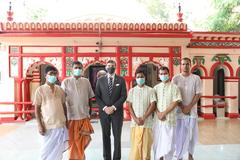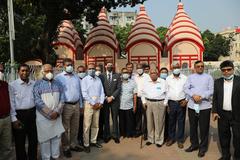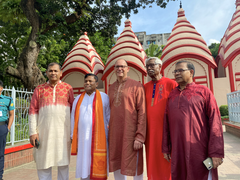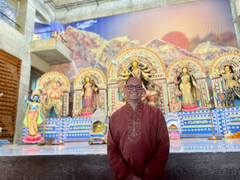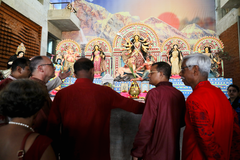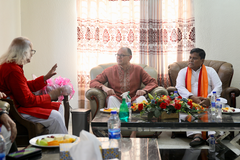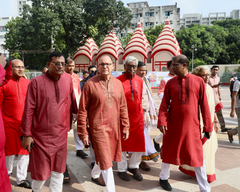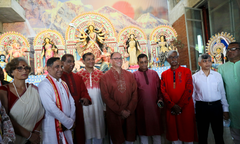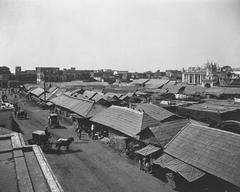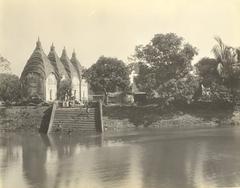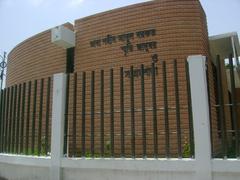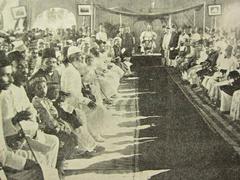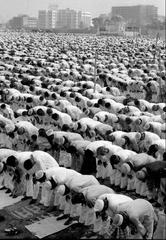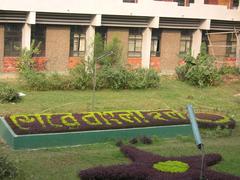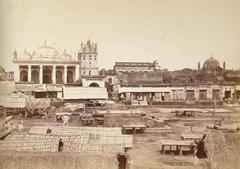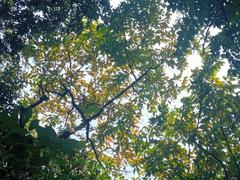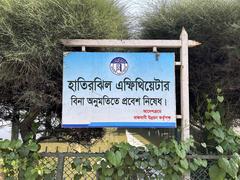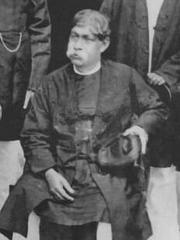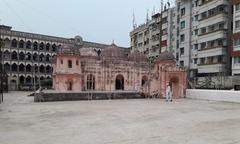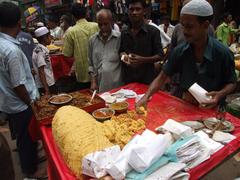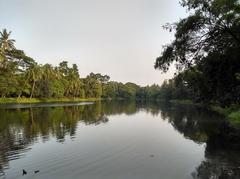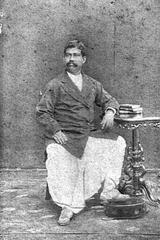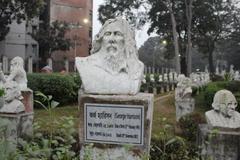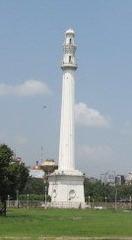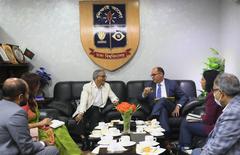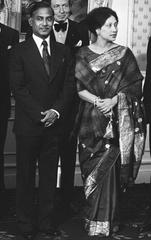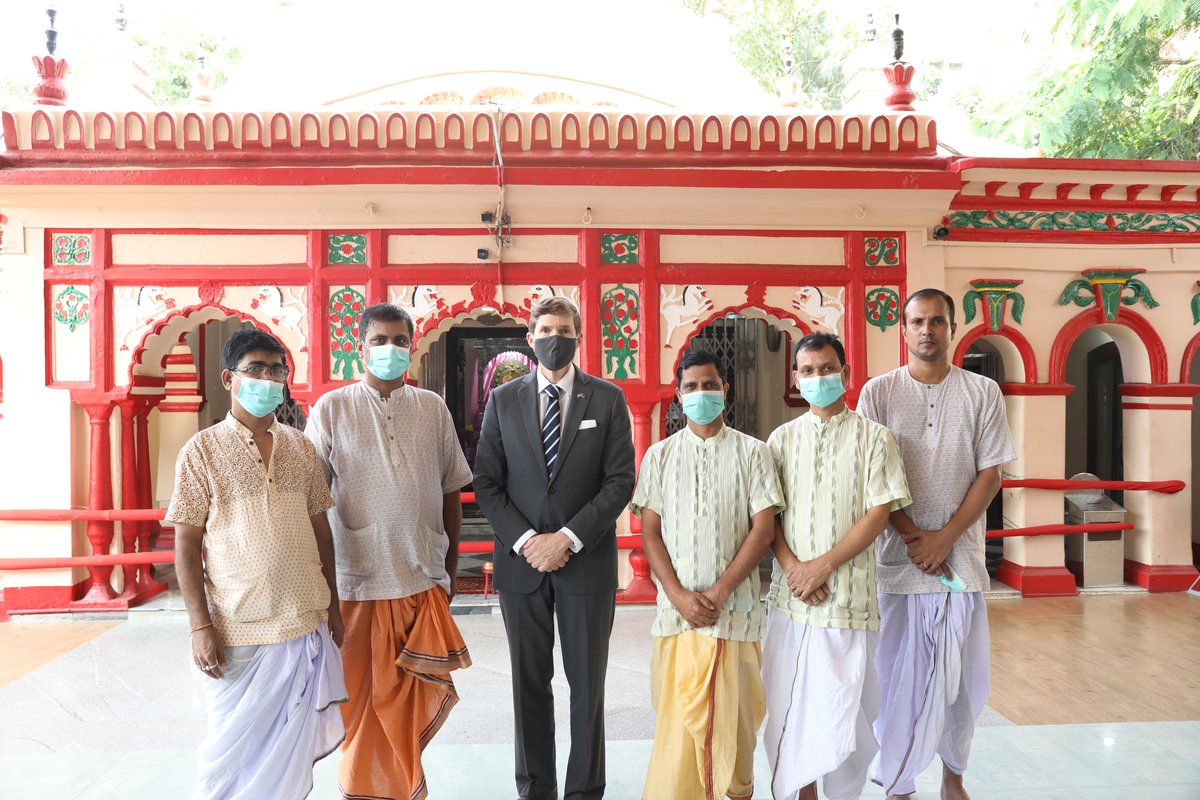
Dhakeshwari Temple Visiting Hours, Tickets, and Guide to Dhaka Historical Sites
Date: 14/06/2025
Introduction
In the vibrant heart of Old Dhaka stands the Dhakeshwari Temple, a monument that encapsulates the spiritual heritage and cultural diversity of Bangladesh. Revered as the “National Temple of Bangladesh,” this historic Hindu shrine is dedicated to Goddess Dhakeshwari—a deity so integral that the city of Dhaka is believed to derive its very name from her. Established in the 12th century by King Ballal Sen of the Sena dynasty, the temple has survived centuries of political and social change, serving as both a spiritual sanctuary and a cultural landmark for Hindus across the country (Heritage Bangladesh Foundation; 3wlink.com).
Blending Bengali and Mughal architectural styles, Dhakeshwari Temple features ornate terracotta embellishments and traditional motifs that narrate ancient Hindu epics. The temple complex hosts daily worship, major festivals like Durga Puja and Kali Puja, and cultural programs that foster community spirit and religious harmony. As a living monument, it stands not only as a site of devotion but also as a testament to the resilience and pluralism of Bangladesh’s capital (TravelTriangle; chiamhuiy.com).
This detailed guide offers prospective visitors essential information on Dhakeshwari Temple’s visiting hours, ticket policies, accessibility, and visitor etiquette, alongside insights into its historical significance, architectural marvels, and nearby attractions. Whether you are a pilgrim seeking spiritual solace, a history enthusiast, or a traveler eager to immerse yourself in Bangladesh’s culture, this article will equip you with everything you need for a meaningful visit (TravelSetu; Trip.com).
Table of Contents
- Introduction
- History of Dhakeshwari Temple
- Visiting Hours and Ticket Info
- Visitor Guidelines and Accessibility
- Cultural Significance and Major Festivals
- Architectural Features
- Preservation and Restoration Efforts
- Travel Tips
- Location and How to Reach
- Nearby Historical Attractions
- Frequently Asked Questions (FAQs)
- Summary and Conclusion
- Sources
History of Dhakeshwari Temple
Origins and Legends
Dhakeshwari Temple dates back to the 12th century, attributed to King Ballal Sen of the Sena dynasty. According to legend, the king discovered the idol of the goddess in a forest and constructed the temple on that sacred spot, cementing the goddess’s association with the city (Heritage Bangladesh Foundation; Koryo Group).
Architectural Evolution and Restoration
The temple has undergone multiple reconstructions, blending traditional Hindu, Bengali, and Mughal styles. In the 19th century, it featured a five-spired (“panchratna”) structure, a Natamandir (dancing hall), a large pond, and the Nahobottola gate. Damages incurred during the Mughal era and the 1971 Bangladesh Liberation War led to extensive restoration by local communities and government bodies (Wikipedia; TravelSetu).
Role During Colonial and Modern Periods
During British rule, the temple became a spiritual and cultural hub for Hindus. After the 1947 Partition, the original idol was moved to Kolkata for safekeeping. Despite this, the temple continued to be a focal point for religious and social gatherings (Wikipedia).
Significance in the Bangladesh Liberation War
During the 1971 Liberation War, the temple suffered damage but emerged as a symbol of hope and resilience for the Hindu community. After independence, it was officially designated the National Temple of Bangladesh (Koryo Group).
Visiting Hours and Ticket Info
- Visiting Hours: Open daily, typically from 6:00 AM to 8:00 PM. Hours may extend to 9:00 PM during major festivals.
- Entry Fee: Entry is free for all visitors. Donations are welcome and help support temple maintenance and charity work (Trip.com).
Visitor Guidelines and Accessibility
- Dress Code: Modest attire is required; both men and women should cover shoulders and knees.
- Footwear: Shoes must be removed at the temple entrance; racks are provided.
- Photography: Permitted in outdoor areas; photography inside the sanctum is restricted—always follow signage and staff instructions.
- Conduct: Maintain silence or low voices, especially during worship and rituals. Walk clockwise around the main shrine as per Hindu tradition.
- Accessibility: The main entrance is wheelchair accessible, but some areas have steps or uneven surfaces. Staff and volunteers often assist visitors with mobility challenges.
Cultural Significance and Major Festivals
Dhakeshwari Temple is recognized as one of the 51 Shakti Peethas, making it a major pilgrimage site. It hosts:
- Durga Puja: The most significant festival, celebrated with elaborate rituals, music, dance, and vibrant decorations.
- Kali Puja & Janmashtami: Marked by night-long prayers, processions, and special cultural programs.
- Community Events: Religious discourses, art exhibitions, and charitable activities are regularly organized (3wlink.com; chiamhuiy.com).
The temple stands as a symbol of religious harmony, often welcoming visitors of all faiths and hosting interfaith dialogues.
Architectural Features
Layout and Spatial Organization
The temple complex covers approximately 18 acres, with the main temple set within a walled compound that includes courtyards, smaller shrines, and community spaces (TravelTriangle).
Main Temple and Subsidiary Shrines
- Main Sanctum: Houses the idol of Goddess Dhakeshwari (Durga).
- Shiva Temples: Four smaller shrines, believed to date back to the 16th century.
- Community Hall and Temple Tank: Used for gatherings and ritual purification (TravelTriangle).
Architectural Styles and Ornamentation
- Features ornate terracotta panels, brickwork, curved cornices, and motifs from Hindu mythology.
- Displays a blend of Bengal’s traditional “aatchala” (eight-roofed) style, Mughal domed spires, and Indo-Islamic decorative elements (Academia.edu; Laure Wanders).
Modern Facilities
Recent additions include a skywalk, car parking, security installations, and signage in Bengali and English, ensuring a visitor-friendly experience while preserving the historical essence (Academia.edu).
Preservation and Restoration Efforts
Dhakeshwari Temple has undergone extensive conservation to address challenges such as environmental wear and urban encroachment. Restoration projects focus on preserving terracotta art, historic structures, and adapting the site for contemporary use without compromising its sanctity (Academia.edu).
Travel Tips
- Best Time to Visit: Early mornings or late afternoons for a peaceful atmosphere; avoid peak festival crowds unless seeking a vibrant celebration.
- What to Bring: Bottled water, a scarf or shawl, and comfortable footwear (to be removed inside).
- Safety: Keep valuables secure, especially during festivals. Carry hand sanitizer and drink only bottled or filtered water (btraveler.com).
- Local Experience: Engage with local vendors and devotees for deeper cultural insights and try authentic Bangladeshi snacks.
Location and How to Reach
- Address: Dhakeshwari Road, Bakshi Bazar, Old Dhaka, Bangladesh.
- Transport: Easily accessible by rickshaw, taxi, or public bus. Ride-sharing apps provide reliable directions. Parking is limited—public transport is recommended.
- Nearby Landmarks: Close to New Market (2 km), Sadarghat river port (3 km), Lalbagh Fort, and the University of Dhaka (btraveler.com; travelsetu.com).
Nearby Historical Attractions
- Lalbagh Fort: 17th-century Mughal fort complex.
- Ahsan Manzil: The Pink Palace on the Buriganga River.
- Shankhari Bazaar: Historic Hindu neighborhood with traditional crafts.
- National Museum of Bangladesh: Showcasing the nation’s history and art.
These sites, along with the temple, represent the rich tapestry of Dhaka’s heritage (Trip.com).
Frequently Asked Questions (FAQs)
Q: What are the Dhakeshwari Temple visiting hours?
A: Open daily from 6:00 AM to 8:00 PM (sometimes until 9:00 PM during festivals).
Q: Is there an entry fee or tickets required?
A: No, entry is free for everyone. Donations are welcome.
Q: Can tourists and non-Hindus visit the temple?
A: Yes, visitors of all faiths are welcome.
Q: Is photography allowed inside the temple?
A: Permitted in outdoor areas; restricted in the sanctum and during rituals.
Q: Is the temple accessible for people with disabilities?
A: The entrance is wheelchair accessible, but some areas have steps or uneven ground.
Q: Are guided tours available?
A: Guided tours are occasionally available through local operators, especially during festivals.
Summary
Dhakeshwari Temple is an indispensable landmark reflecting the spiritual vitality, architectural richness, and cultural diversity of Dhaka. Its enduring presence since the 12th century, through times of conflict and social change, embodies the resilience of Bangladesh’s Hindu community and the nation’s pluralistic spirit (Koryo Group; chiamhuiy.com). Free entry, inclusive practices, and proximity to other historic sites make it a highlight for pilgrims, tourists, and cultural enthusiasts.
Whether you witness the grandeur of Durga Puja or admire the intricate terracotta artistry, your visit promises immersion in devotion, history, and community life. Observing modest dress codes, respectful behavior, and engaging with local guides will further enrich your experience (TravelTriangle; TravelSetu). For a seamless trip, use mobile resources like Audiala for real-time updates, and explore nearby cultural sites for a comprehensive journey through Dhaka’s heritage (3wlink.com; btraveler.com).
Sources
- Dhakeshwari Mandir: A Sacred Heritage Site in Bangladesh, Heritage Bangladesh Foundation
- Dhakeshwari Temple - Wikipedia
- Dhakeshwari Temple Tourism History, TravelSetu
- Dhakeshwari Temple: A Must-Visit Religious Site in Bangladesh, 3wlink.com
- Dhakeshwari Temple Guide, Koryo Group
- Exploring the Divine Beauty of Dhakeshwari Temple in Dhaka, btraveler.com
- Dhakeshwari Temple in Dhaka: Visiting Hours, Tickets & Historical Guide, TravelTriangle
- Dhakeshwari Temple: A Cultural and Religious Landmark, Chiamhuiy
- Dhakeshwari Temple - Trip.com Travel Guide
- Historic Preservation of Dhakeshwari Temple, Academia.edu
- Places to Visit in Dhaka, Laure Wanders
For more travel insights, download the Audiala app or consult our guides on Dhaka’s top historical sites. Follow us on social media for the latest updates.
